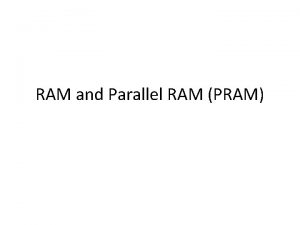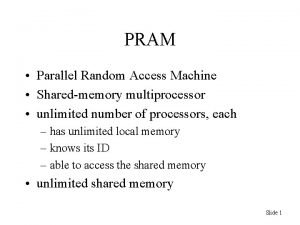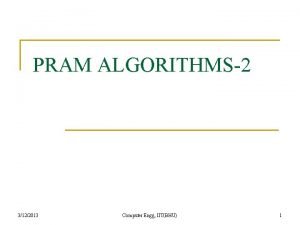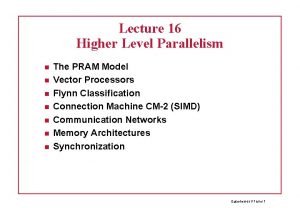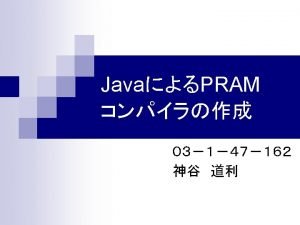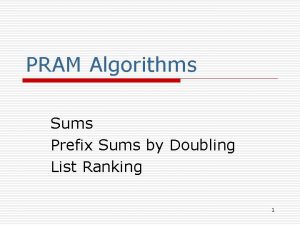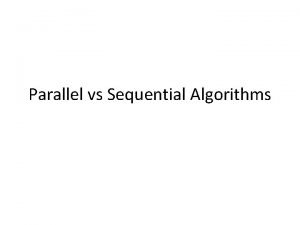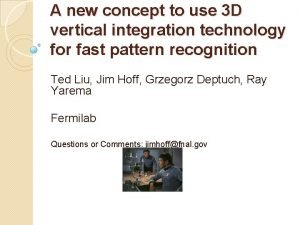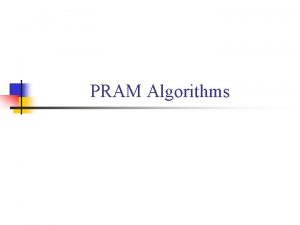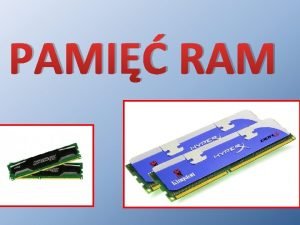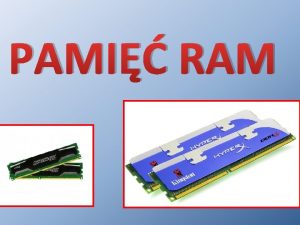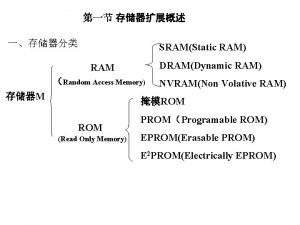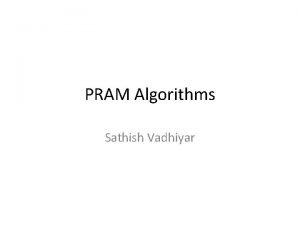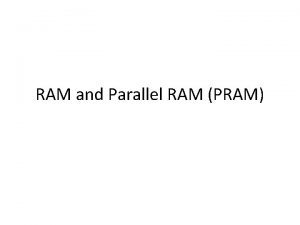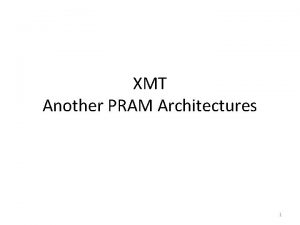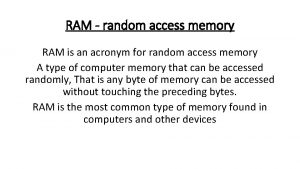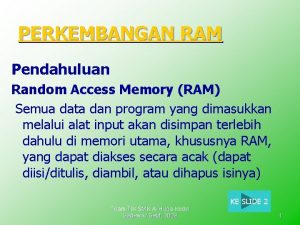PRAM model RAM 1 2 3 Random Access












![Example CREW-PRAM • Assume initially table A contains [0, 0, 0, 1] and we Example CREW-PRAM • Assume initially table A contains [0, 0, 0, 1] and we](https://slidetodoc.com/presentation_image_h2/4745be76e01c085522b8723a6eab56e5/image-13.jpg)




- Slides: 17

PRAM model

RAM 1 2 3 Random Access Machine Base for PRAM Computation unit with a user defined program. • Read-only input tape and write-only output tape. • Unbounded number of local memory cells. • Each memory cell is capable of holding an integer of unbounded size. • Execution starts with the first instruction and ends when a HALT instruction m • All operations take unit time regardless of the lengths of operands. • Time complexity = the number of instructions executed. • Space complexity = the number of memory cells accessed.

PRAM • • • PRAM - Parallel Random Access Machine Extension of RAM Shared-memory multiprocessor Used for Performance and Scalability study unlimited number of processors, each – has unlimited local memory – knows its ID – able to access the shared memory in constant time 1 2 3 P 1 P 2 . Pi . . Pn – unlimited shared memory A very reasonable question: Why do we need a PRAM model? • to make it easy to reason about algorithms • to achieve complexity bounds • to analyze the maximum parallelism m

PRAM MODEL 1 2 3 P 1 P 2 . Pi . ? Common Memory . . . Pn m PRAM n RAM processors connected to a common memory of m cells ASSUMPTION: at each time unit each Pi can read a memory cell, make an internal computation and write another memory cell. CONSEQUENCE: any pair of processor Pi Pj can communicate in constant time! Pi writes the message in cell x at time t Pi reads the message in cell x at time t+1

Summary of assumptions for PRAM • Inputs/Outputs are placed in the shared memory (designated address) • Memory cell stores an arbitrarily large integer • Each instruction takes unit time • Instructions are synchronized across the processors PRAM Instruction Set • accumulator architecture – memory cell R 0 accumulates results • multiply/divide instructions take only constant operands – prevents generating exponentially large numbers in polynomial time

PRAM Complexity Measures • for each individual processor – time: number of instructions executed – space: number of memory cells accessed • PRAM machine – time: time taken by the longest running processor – hardware: maximum number of active processors

Two Technical Issues for PRAM • How processors are activated • How shared memory is accessed

Processor Activation • P 0 places the number of processors (p) in the designated shared-memory cell – each active Pi, where i < p, starts executing – O(1) time to activate – all processors halt when P 0 halts p . . . • Active processors explicitly activate additional processors via FORK instructions – tree-like activation – O(log p) time to activate 1 0 0 0 i processor will activate a processor 2 i and a processor 2 i+1

PRAM • Too many interconnections gives problems with synchronization • However it is the best conceptual model for designing efficient parallel algorithms – due to simplicity and possibility of simulating efficiently PRAM algorithms on more realistic parallel architectures Basic parallel statement for all x in X do in parallel instruction (x) For each x PRAM will assign a processor which will execute instruction(x)

Shared-Memory Access Concurrent (C) means, many processors can do the operation simultaneously in the same memory Exclusive (E) not concurent • EREW (Exclusive Read Exclusive Write) • CREW (Concurrent Read Exclusive Write) – Many processors can read simultaneously the same location, but only one can attempt to write to a given location • ERCW (Exclusive Read Concurrent Write) • CRCW (Concurrent Read Concurrent Write) – Many processors can write/read at/from the same memory location

Concurrent Write (CW) • What value gets written finally? • Priority CW – processors have priority based on which write value is decided • Common CW – multiple processors can simultaneously write only if values are the same • Arbitrary/Random CW – any one of the values are randomly chosen

Example CRCW-PRAM • Initially – table A contains values 0 and 1 – output contains value 0 • The program computes the “Boolean OR” of A[1], A[2], A[3], A[4], A[5]
![Example CREWPRAM Assume initially table A contains 0 0 0 1 and we Example CREW-PRAM • Assume initially table A contains [0, 0, 0, 1] and we](https://slidetodoc.com/presentation_image_h2/4745be76e01c085522b8723a6eab56e5/image-13.jpg)
Example CREW-PRAM • Assume initially table A contains [0, 0, 0, 1] and we have the parallel program

Pascal triangle PRAM CREW

Parallel Addition • • • log(n) steps=time needed n/2 processors needed Speed-up = n/log(n) Efficiency = 1/log(n) Applicable for other operations too +, *, <, >, == etc.

Membership problem • p processors PRAM with n numbers (p ≤ n) • Does x exist within the n numbers? • P 0 contains x and finally P 0 has to know Algorithm step 1: Inform everyone what x is step 2: Every processor checks [n/p] numbers and sets a flag step 3: Check if any of the flags are set to 1

THE PRAM IS A THEORETICAL (UNFEASIBLE) MODEL • The interconnection network between processors and memory would require a very large amount of area. • The message-routing on the interconnection network would require time proportional to network size (i. e. the assumption of a constant access time to the memory is not realistic). WHY THE PRAM IS A REFERENCE MODEL? • Algorithm’s designers can forget the communication problems and focus their attention on the parallel computation only. • There exist algorithms simulating any PRAM algorithm on bounded degree networks. Statement 1. A PRAM algorithm requiring time T(n), can be simulated in a mesh of tree in time T(n)=log 2 n/loglogn, that is each step can be simulated with a slow-do of log 2 n/loglogn. Statement 2. Any problem that can be solved for a p processor PRAM in t steps can be solved ina p’ processor PRAM in t’=O(tp/p’) steps • Instead of design ad hoc algorithms for bounded degree networks, design more general algorithms for the PRAM model and simulate them on a feasible network.
 Pram models
Pram models Ram nam me lin hai dekhat sabme ram
Ram nam me lin hai dekhat sabme ram Pram model of negotiation
Pram model of negotiation Pram model
Pram model In random access machine, instructions are executed
In random access machine, instructions are executed Pram
Pram Pipelineing
Pipelineing Elements of modern computer
Elements of modern computer Nistir 8062
Nistir 8062 Score pram asthme
Score pram asthme Pram
Pram Prefix doubling
Prefix doubling Pram
Pram Pram
Pram Random assignment vs random sampling
Random assignment vs random sampling Random assignment vs random selection
Random assignment vs random selection Disadvantages of indexed sequential file organization
Disadvantages of indexed sequential file organization Disadvantages of random access memory
Disadvantages of random access memory
